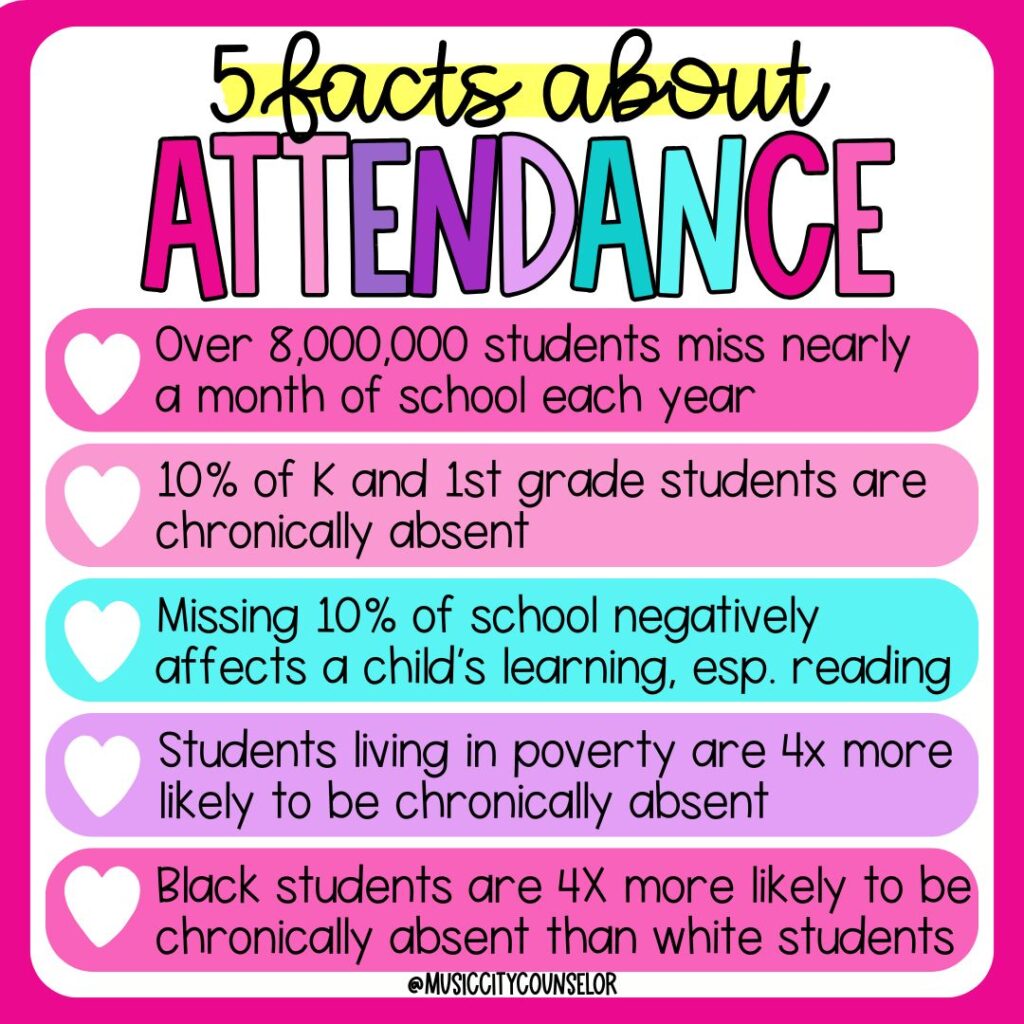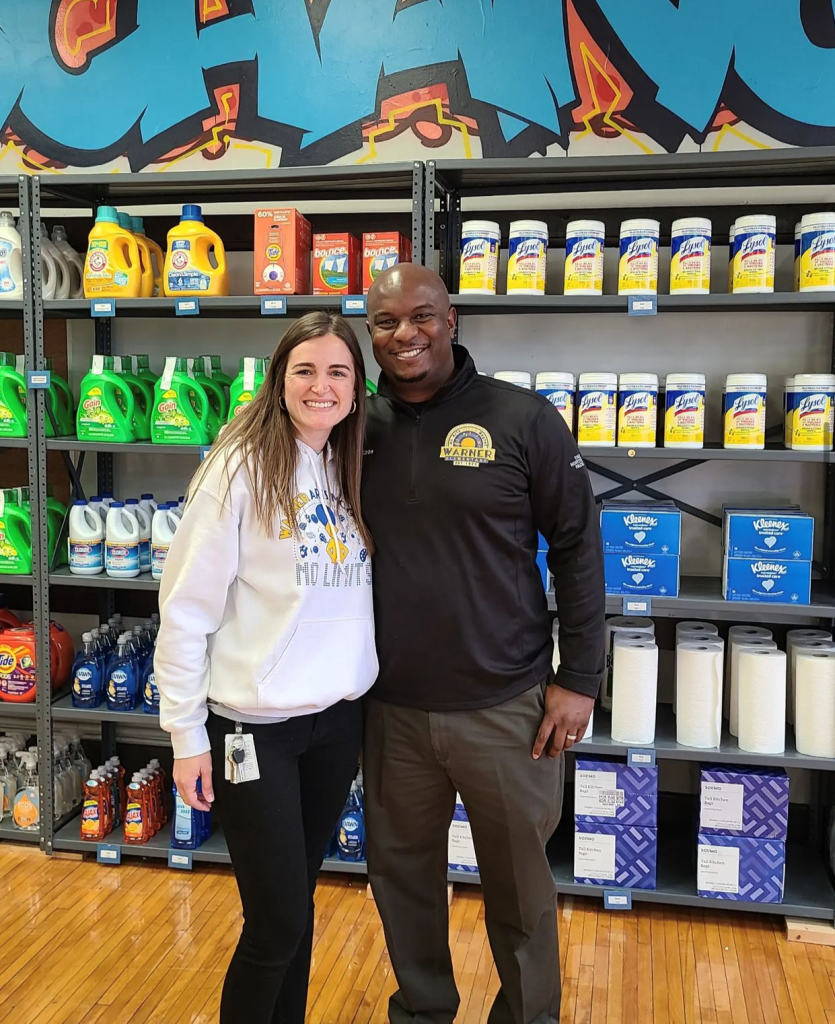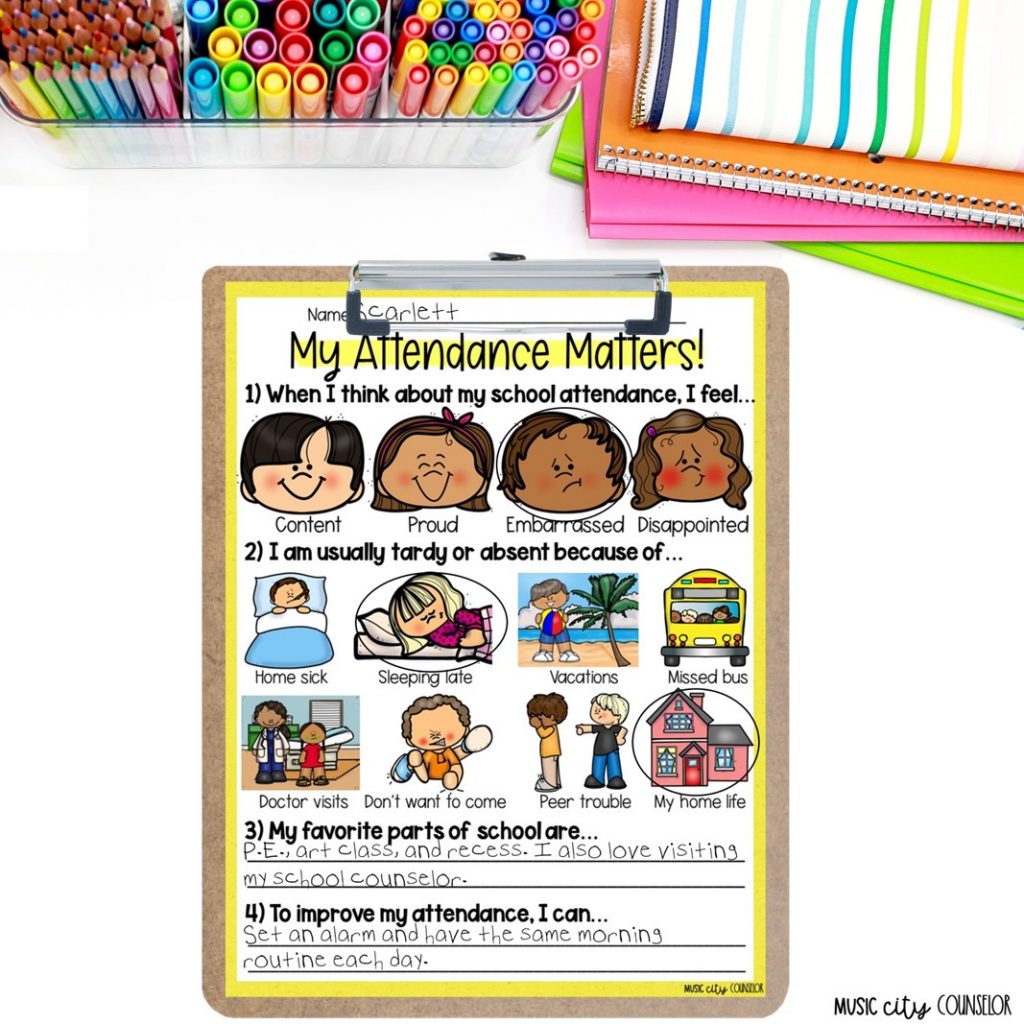
Hey y’all! Thanks so much for stopping by. My name is Laura and I am an Elementary School Counselor turned Curriculum Writer. At my precious school in Nashville, TN, 97% of my students were living in …

Did you know that, since the pandemic began, 72% of public schools in the U.S. report an increase in chronic absenteeism? (National Center for Education Statistics). All students’ learning and school experiences were interrupted in 2020-2021. But what is even more concerning is that millions of chronically absent children continue to miss out on the invaluable benefits of school, including opportunities for academic growth, learning, social-emotional development, friendships, stable meals, positive relationships with safe adults, and more.
The impact of chronic absenteeism on students’ development and future is just too steep to continue missing school!
In this post, I will review facts about attendance and five intervention ideas to support students who are chronically absent. I will also provide a free attendance survey that you can use to gather data and support students!

The statistics on chronic absenteeism in the United States are quite shocking (and upsetting)! I gathered some information from Attendance Works and the U.S. Department of Education below to show you just how severe and prevalent this issue is for our children:
The disparities in income, race, and disability status when it comes to chronic absenteeism are staggering. Our nation’s most vulnerable children are also those that are the most likely to miss school and all of the stability, safety, and potential for growth that it brings.
This issue is all too familiar for my former principal, and hero, Dr. Ricki Gibbs II, the leader at Warner Elementary in Nashville, TN. Almost all of his students are living in poverty, and 90% of them are African American. Chronic absenteeism was a daily struggle at his school until one day, his Communities in Schools Social Worker Ali Jenkins came to him with a crazy idea. And from there, the “Warner Exchange” was born!

Ms. Jenkins explained, “The Warner Exchange came about after months of listening to families, and hearing a connection between students missing school and lacking basic necessities.” So, she and Dr. Gibbs came up with a revolutionary idea: caregivers bring their child to school, and in exchange, are provided with the basic necessities that their families so desperately need. Each day that a student attends school, they earn 5 Warner Bucks. Their Warner Bucks are tallied, and once a month, parents use their bucks to go shopping in the school store. From laundry detergent to dish soap to paper towels to Clorox wipes, the Warner Exchange has everything that their community needs. The school partners with local businesses, agencies, and families to keep their shelves stocked. It’s a win-win for everyone!
Ms. Jenkins shared that one mom said, “Oh my gosh, I wish my Kroger looked like this!” Another said, “I’ve been working so hard to get them to school, just so I could shop today.” This program has truly changed lives at Warner, and has the potential to impact so many more students if other schools choose to replicate it! Is this a system that you think would benefit your school community? Why or why not? Please comment below!
A more simple, but still effective approach to improving attendance in children living in poverty is to offer gift card incentives to caregivers. At my urban, Title I elementary school that served mostly English Learners, our Communities in Schools social worker met with caregivers of chronically absent students to set attendance goals. Once the family reached their goal, she rewarded them with donated gas, Walmart, and grocery gift cards. As you can imagine, this incentive was highly motivating and meaningful for caregivers, and for students too!

To help you identify and support students who are chronically absent, I created this free attendance survey. It offers helpful information about students’ feelings about their attendance and their most common reasons for missing school. It also lets students share their favorite parts of school and ideas they have for improving their attendance. This survey is a great starting point for individual and small group counseling, and developing intervention and support plans for students in need.

Another way to combat chronic absenteeism and tardiness is with this set of Attendance Intervention Boards that I created. This system helps identify barriers to attendance, track patterns in behavior, and motivate students (and their caregivers) to attend school.
They work very similarly to traditional token boards:
Not only is this system super motivating to children, but it generates critical data that helps educators develop intervention plans, and put supports in place to improve attendance. How do you think that your students, educators, and caregivers would respond to this resource? Please comment below!

If you know me, you know that I love lap books! They are easily created and stored in a file folder, reusable, and can be pulled out at a moment’s notice to help a student in need. I use hook-and-loop fastener dots to make them interactive. To support students who are chronically absent or tardy, I created this Attendance Lap Book. It lets students explore their feelings about their attendance, the reasons behind them missing school, and what motivates them most about attending school. The resource also teaches students why school attendance is important and tips for arriving to school on time. I also included reflection questions to spark discussion! This resource is super helpful and effective in attendance small groups, individual counseling, check-in/check-out, and more!
I hope that this post offered helpful information and interventions to support your chronically absent and tardy students! Which strategies have been most successful with your students? Please comment below, I’d love to hear from you!

| Cookie | Duration | Description |
|---|---|---|
| cookielawinfo-checkbox-analytics | 11 months | This cookie is set by GDPR Cookie Consent plugin. The cookie is used to store the user consent for the cookies in the category "Analytics". |
| cookielawinfo-checkbox-functional | 11 months | The cookie is set by GDPR cookie consent to record the user consent for the cookies in the category "Functional". |
| cookielawinfo-checkbox-necessary | 11 months | This cookie is set by GDPR Cookie Consent plugin. The cookies is used to store the user consent for the cookies in the category "Necessary". |
| cookielawinfo-checkbox-others | 11 months | This cookie is set by GDPR Cookie Consent plugin. The cookie is used to store the user consent for the cookies in the category "Other. |
| cookielawinfo-checkbox-performance | 11 months | This cookie is set by GDPR Cookie Consent plugin. The cookie is used to store the user consent for the cookies in the category "Performance". |
| viewed_cookie_policy | 11 months | The cookie is set by the GDPR Cookie Consent plugin and is used to store whether or not user has consented to the use of cookies. It does not store any personal data. |
2 Responses
HI , do you guys have other ideas of parents of how to do incentives to parents? I love the bucks/ store idea however how can I the $$$ to make up our family store?
Thank you,
Great point, Tania! My principal’s store is funded through donations from the community. He has an Amazon wish list and shares it with local churches and charitable organizations.